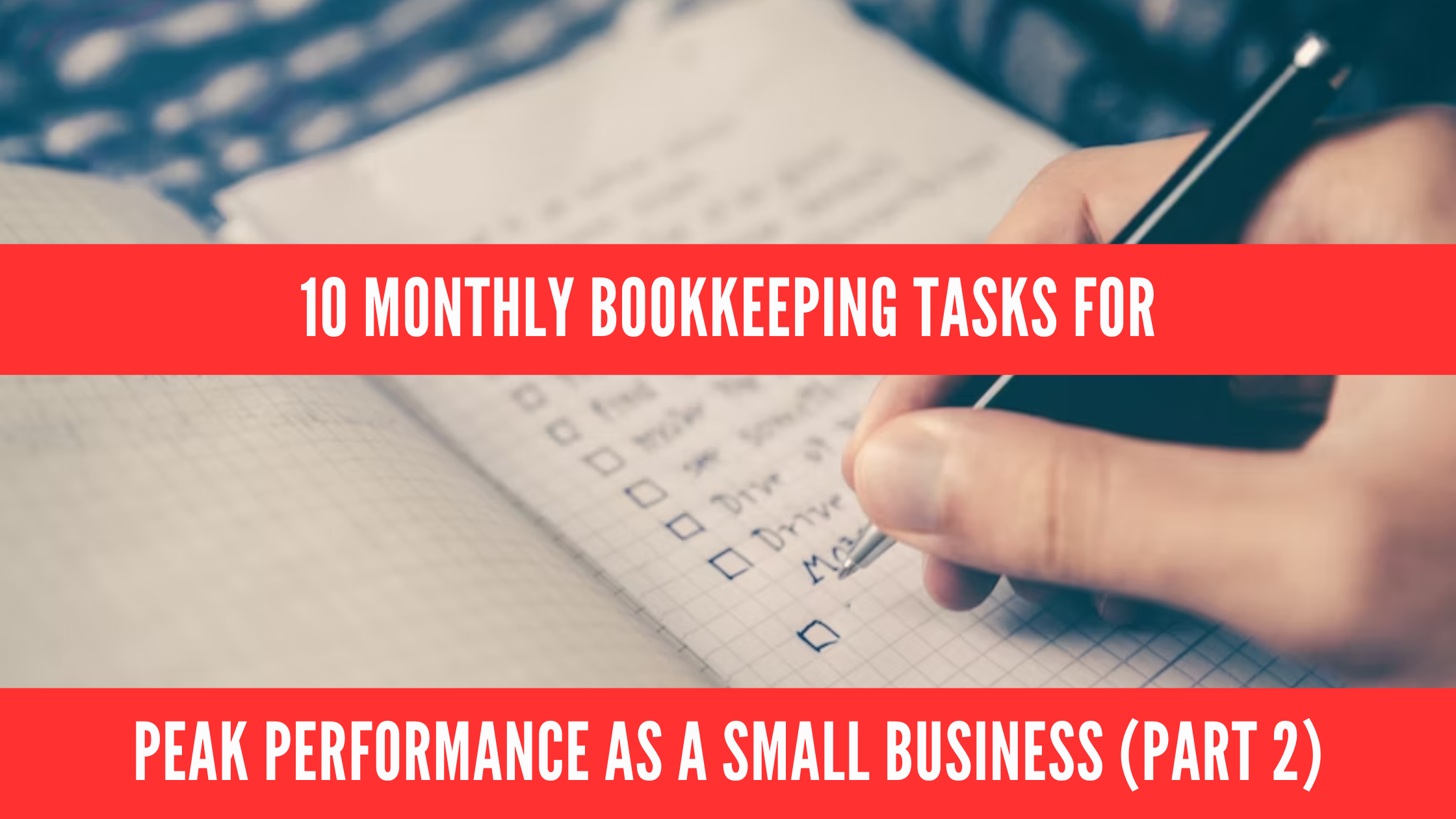
What’s the difference between bookkeeping and great bookkeeping? The amount of insight you gain. Do you keep up with your bookkeeping but still feel lost or torn trying to manage your business’ finances? Instead of hiring a financial advisor, the answer is usually to
Great bookkeeping brings you better business decisions, peace of mind, and saves you time. You’re about to see how, by practicing the ten monthly bookkeeping tasks that define peak performance as a small business.
If you need to start from the beginning of the checklist, look no further: 10 Monthly Bookkeeping Tasks For Peak Performance As A Small Business (Part 1)
In part two, you’ll learn to:
- Review your inventory and receipts.
- Reconcile your business transactions.
- Calculate and record sales tax.
- Perform the month-end closing process.
- (A secret tip that puts a smile on any entrepreneur’s face.)
#6: Review Your Inventory And Receipts
The last thing you want is a supply shortage that leaves you unable to fulfill requests from customers. Do a quick check on your inventory at least once a month. Before, during, and after peak periods, inventory checks should be done even more often.
Additionally, check your receipts. Has a personal expense inadvertently slipped into your bookkeeping? Accidents happen. Chuckle about it now as you resolve the error before tax time rather than sweat in front of an auditor.
After your receipts are confirmed error-free, make sure a digital copy exists. If you keep paper receipts, simply make a folder on a cloud storage platform like Google Drive, which is free to start. Then, take clear pictures of your receipts and upload them to the folder. It helps if you’re patient enough to name them descriptively — or at least dump each month’s load into a separate folder.
Did you know: You can’t use your bank statements to justify your expenses or deductions. You absolutely need a physical or digital receipt, with all relevant details, which are not included in bank statements.
#7: Reconcile Your Business Transactions
At this point, you would have caught any invoice payments, payroll entries, and sneaky receipts that could alter your transaction totals. That means it’s safe to reconcile your business transactions. This usually means a credit, debit, and cash account, but there may be more depending on your finances.
If you manually entered the transactions and your balances don’t match at the end, you may have pressed the wrong number at some point. If upon triple-checking, that’s not the case (or your transaction entry is automated) keep an eye out for double charges, failed/bounced transactions, pending cheques/wires, or even suspicious activity.
You can only get an accurate idea of your cash position when your books balance. However, if there’s a pesky small error you just can’t seem to resolve, label it clearly as a reconciliation error, then move on and save yourself the frustration.
#8: Calculate And Record Sales Tax
As a small business in Brampton, or anywhere else in Ontario, you’ll have to register to collect GST/HST if:
- You sell taxable items and/or services to anyone, worldwide.
- Your taxable revenue exceeds $30,000 in a single calendar quarter.
There are some caveats that may exempt you from sales tax. These include:
- You provide a substantial amount of financial services, capital property sales, or goodwill supplies: All of these are excluded from the $30,000 revenue threshold.
- Your items and services are supplied to people outside of Canada. You are not exempt if international customers make purchases from your business while within Canada.
If you make a sale within Canada but in a different province, follow the sales tax laws of that province.
Head spinning already? This is where choosing the right bookkeeping software comes in clutch. Many programs can automatically log your sales and calculate sales tax even in the most convoluted international scenarios.
#9: Perform The Month-End Closing Process
The way bookkeeping works, temporary accounts should be closed out. That’s so at the beginning of the next period, the accounts start from zero. Think of it like this: You’re confirming the accuracy of this month’s financial data in order to start next month with fresh records and no risk of mistakes carrying over.
To completely close out your bookkeeping, here’s what the average business needs to gather:
- Bank account information
- General ledger
- Total revenue numbers
- Income and expense accounts
- Inventory levels
- Balance sheets
- Petty cash total
- Financial statements
- Total fixed assets
If you’re unfamiliar with the process of reconciling your accounts, or you’d simply appreciate help, contact us. Our bookkeepers are certified in popular programs, such as QuickBooks, but can also crunch numbers the old-fashioned way.
#10: Enjoy The Benefits Of Bookkeeping Best Practices
Don’t skip this part! After you give a quick round of applause, remember that enjoying good bookkeeping is a conscious process. Think about the extra peace of mind you have now and the frustrating discrepancies you’ve saved yourself.
Look at the insights you’ve drawn from your accurate financial reports. Now every time your business decisions work out, you can thank your bookkeeping. Knowledge is power.
If you’d like more power, contact us to have a certified financial planner review your business. We’ll genuinely listen to your circumstances, then work with you on a high-quality action plan to achieve the goals you set.





